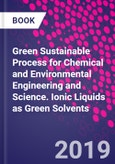Green Sustainable Process for Chemical and Environmental Engineering and Science: Ionic Liquids as Green Solvents discusses the application of ionic liquids as environment-friendly solvents in the extraction, separation and purification of organic and inorganic compounds, as reaction media in biochemical and chemical reactions and catalysis, and in green organic and drug syntheses. It covers various industrial applications, from polymer synthesis, to biodiesel and lubrication, paint and pigments, water softening and dry-cleaning, ore refining, the nuclear industry, aerogels, fuel cells, and more. Specific sections cover hydrogenation, oxidation, hydroformylation, acylation, acetylation, dimerization, oligomerization, photochemical and cleavage of ethers reactions.
The book's main emphasis lies in the extraction and separation of biomolecules, vitamins, proteins, enzymes, and DNA using ionic liquids as green solvents. High-performance thin layer chromatography and gas chromatography are also discussed.
Please Note: This is an On Demand product, delivery may take up to 11 working days after payment has been received.
Table of Contents
1. Stability and solubility of biomolecules in ionic liquids2. Ionic liquid in separation of biomolecules
3. Ionic liquid in extraction of biomolecules
4. Use of ionic liquids thin layer chromatographic separation
5. Green solvents for bio-catalysis
6. Ionic liquids as green solvents for drugs synthesis
7. Ionic liquids as green bio-lubricant additives
8. Ionic liquids as green solvents in organic synthesis
9. Polymer synthesis in ionic liquids
10. Ionic liquids as scavenger
11. Antistatic agent for cleaning fluids
12. Ionic liquids as corrosion inhibitors
13. Ionic liquids as solvents in biodiesel production
14. Ionic liquid based membranes for water softening
15. Ionic liquids for olefin reactions
16. Ionic liquids as compatibilizer for pigments
17. Ionic liquids in hydrogenation reactions
18. Ionic liquids in oxidation reactions
19. Ionic liquids in hydroformylation reactions
20. Ionic liquids in acylation and acetylation reactions
21. Ionic liquids in dimerization and oligomerization ionic liquids
22. Ionic liquids in cleavage of ethers reactions
Authors
Dr. Inamuddin Department of Applied Chemistry, Zakir Husain College of Engineering and Technology, Faculty of Engineering and Technology, Aligarh Muslim University, Aligarh, India. Dr. Inamuddin, is an assistant professor at Department of Applied Chemistry, Zakir Husain College of Engineering and Technology, Faculty of Engineering and Technology, Aligarh Muslim University, Aligarh, India. He has extensive research experience in multidisciplinary fields of analytical chemistry, materials chemistry, electrochemistry, renewable energy and environmental science. He has worked on different research projects funded by various government agencies and universities and is the recipient of awards, including the Fast-Track Young Scientist Award and young researcher of the year award-2020 of the university. He has published about 177 research articles in various international scientific journals, 18 book chapters, and 120 edited books with multiple well-known publishers. His current research interests include ion exchange materials, a sensor for heavy metal ions, biofuel cells, supercapacitors and bending actuators. Abdullah M. Asiri Professor, Chemistry Department, Faculty of Science-King Abdulaziz University, Saudi Arabia. Abdullah Mohammed Ahmed Asiri is a full Professor in the Chemistry Department, at the Faculty of Science, King Abdulaziz University, Saudi Arabia. His research interests include: color chemistry, synthesis of novel photochromic and thermochromic systems, synthesis of novel colorants and coloration of textiles and plastics, molecular modeling, applications of organic materials into optics such as OEDS, high performance organic dyes and pigments, new applications of organic photochromic compounds, organic synthesis of heterocyclic compounds as precursor for dyes, synthesis of polymers functionalized with organic dyes, preparation of some coating formulations for different applications. Suvardhan Kanchi Department of Chemistry, Sambhram Institute of Technology, M.S. Palya, Jalahalli East, Bengaluru 560097, India. Dr. Kanchi is the Research Scientist in fabricating the bio-sensors for the identification and quantification of high-intensity artificial sweeteners in food stuffs and biological samples. He completed his post doctoral research in Separation and Determination of High-Intensity Artificial Sweeteners (Sucralose, Neotame & Stevia glycosides with Capillary Electrophoresis and electrochemical methods (biosensors) in different Food Stuff's from Durban University of Technology, Durban, South Africa. He is associated with the Indian Society of Analytical Scientists (ISAS), India. He is also serving as the Executive Editor for American Journal of Phytomedicine and Clinical Therapeutics; EB member for International Journal of Research in Chemistry and Environment and many more. He is also having several reviewer experiences for many articles.Costing: option 1 with proofredaing








